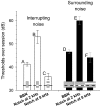Illusory sound perception in macaque monkeys
- PMID: 14534249
- PMCID: PMC6740835
- DOI: 10.1523/JNEUROSCI.23-27-09155.2003
Illusory sound perception in macaque monkeys
Abstract
In most natural listening environments, noise occludes objects of interest, and it would be beneficial for an organism to correctly identify those objects. When a sound of interest ("foreground" sound) is interrupted by a loud noise, subjects perceive the entire sound, even if the noise was intense enough to completely mask a part of it. This phenomenon can be exploited to create an illusion: when a silent gap is introduced into the foreground and high-intensity noise is superimposed into the gap, subjects report the foreground as continuing through the noise although that portion of the foreground was deleted. This phenomenon, referred to as auditory induction or amodal completion, is conceptually similar to visual induction, fill-in, illusory motion, and illusory contours. Two rhesus macaque monkeys performed a task designed to assess auditory induction. They were trained to discriminate complete stimuli from those containing a silent gap in the presence of two types of noise. Interrupting noise temporally coincided only with the gap, and in humans this causes induction. Surrounding noise temporally encompassed the entire foreground, and in humans this causes masking without auditory induction. Consistent with previous human psychophysical results, macaques showed better performance with surrounding masking noise than interrupting noise designed to elicit induction. These and other control experiments provide evidence that primates may share a general mechanism to perceptually complete missing sounds.
Figures







References
-
- Assad JA, Maunsell JH ( 1995) Neuronal correlates of inferred motion in primate posterior parietal cortex. Nature 373: 518-521. - PubMed
-
- Bennett KB, Parasuraman R, Howard Jr JH, O'Toole AJ ( 1984) Auditory induction of discrete tones in signal detection tasks. Percept Psychophys 35: 570-578. - PubMed
-
- Bregman AS ( 1990) Auditory scene analysis: the perceptual organization of sound. Cambridge, MA: MIT.
-
- Ciocca V, Bregman AS ( 1987) Perceived continuity of gliding and steady-state tones through interrupting noise. Percept Psychophys 42: 476-484. - PubMed
-
- Dannenbring GL, Bregman AS ( 1976) Effect of silence between tones on auditory stream segregation. J Acoust Soc Am 59: 987-989. - PubMed
Publication types
MeSH terms
Grants and funding
LinkOut - more resources
Full Text Sources
Miscellaneous
